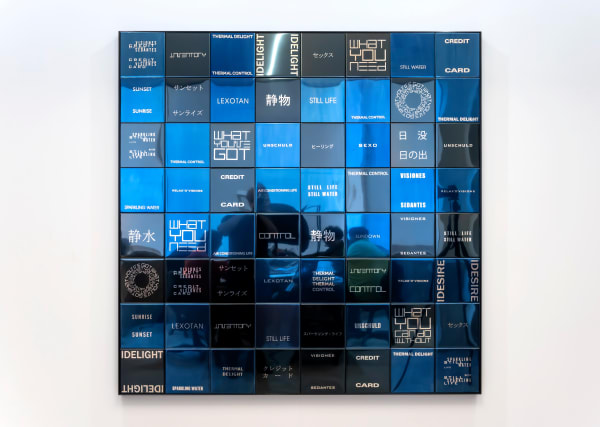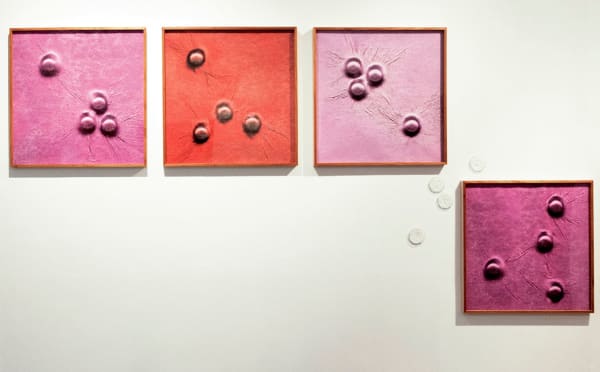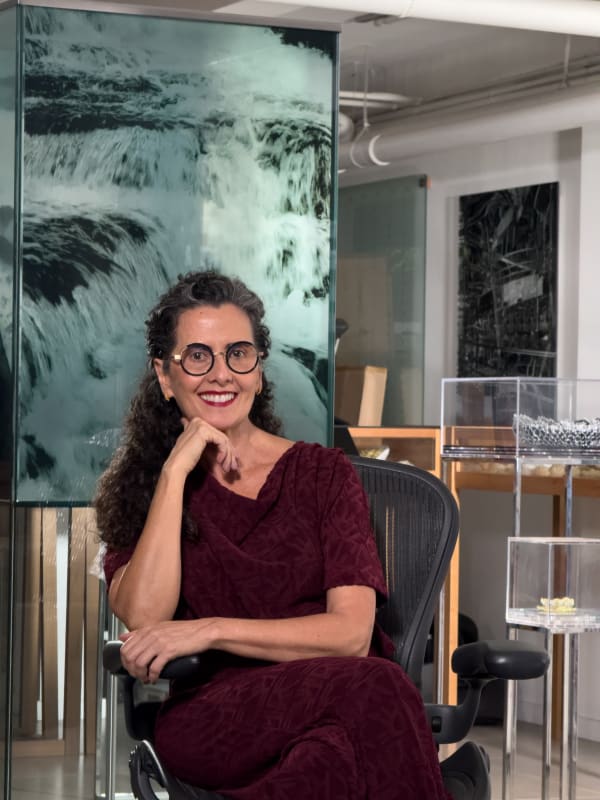Ana Maria Tavares Vive e trabalha em São Paulo, b. 1958
-
 Ana Maria TavaresPitaya II, 2024Impressão sobre seda89 x 89 cmEdição: 1/10
Ana Maria TavaresPitaya II, 2024Impressão sobre seda89 x 89 cmEdição: 1/10 -
 Ana Maria TavaresForgotten Mantras III, 2022Aço inox colorido e gravado, ACM e alumínio162 x 162 x 8 cm
Ana Maria TavaresForgotten Mantras III, 2022Aço inox colorido e gravado, ACM e alumínio162 x 162 x 8 cm -
 Ana Maria TavaresGold Mantra Labyrinth Mozaik (da série BB Universal Gold Mantras), 2021Aço inox colorido e gravado, ACM e alumínio anodizado162 x 162 x 8 cmEdição: 1/4
Ana Maria TavaresGold Mantra Labyrinth Mozaik (da série BB Universal Gold Mantras), 2021Aço inox colorido e gravado, ACM e alumínio anodizado162 x 162 x 8 cmEdição: 1/4 -
 Ana Maria TavaresBarragem I (Forest Green), 2019Impressão em papel Hahnemühle Photo Rag Ultra Smooth 305g e aço inox120 x 120 x 8 cm
Ana Maria TavaresBarragem I (Forest Green), 2019Impressão em papel Hahnemühle Photo Rag Ultra Smooth 305g e aço inox120 x 120 x 8 cm -
 Ana Maria TavaresDisjunção Prismática IV (Saturno Black), 2019Aço inox, mármore e alumínio81,4 x 122,6 x 7,6 cm
Ana Maria TavaresDisjunção Prismática IV (Saturno Black), 2019Aço inox, mármore e alumínio81,4 x 122,6 x 7,6 cm -
 Ana Maria TavaresAzulejos Poros (da série Condomínios), 2013Impressão com tinta pigmentada mineral sobre papel Hahnemühle Photo Rag 308g, bordado em ponto arroz, vidro e madeira freijó176 x 362 x 6 cmEdição: 1/5
Ana Maria TavaresAzulejos Poros (da série Condomínios), 2013Impressão com tinta pigmentada mineral sobre papel Hahnemühle Photo Rag 308g, bordado em ponto arroz, vidro e madeira freijó176 x 362 x 6 cmEdição: 1/5
Ana Maria Tavares (Brazil, 1958). Graduated in Visual Arts at FAAP – Fundação Armando Álvares Penteado (1982), master’s degree in fine arts at The School of the Art Institute of Chicago (1986) and PHD degree from the University of São Paulo (2000). Received a Guggenheim Foundation Grant (NY 2001); an Ida Ely Rubin Artist-in-Residence at MIT (Massachusetts 2007); a Lynette S. Autrey Visiting Scholars da Rice University (Houston 2014). Professor and researcher in arts since 1982. Between 1993-2017 taught at ECA/USP, in the graduate and undergraduate Program. In 2016 received the São Paulo Critic’s Association Prize of Best Retrospective of the year with the solo show ‘In the Place Itself: an Anthology of Ana Maria Tavares’ work, at Pinacoteca de São Paulo. In her production, the understanding that tropical nature and architecture are ideological constructions in the center of the triad modernism – modernity – modernization, leads to conceptualization of works that interrogate the political, economic and social implications of the modern movement in Brazil. Bringing into the art realm the complicity between the built environment and the utopias of eugenics that the art historian Fabiola López – Durán develops in her research. Tavares’ work trespasses the dichotomies of modernity – progress and backwardness, beauty and ugliness, purity and contamination. Her recent works confront industrial techniques with handcraft, thus leading to the inclusion of the ornament - an element that was eliminated from modern architecture – in order to interrogate gender, race and otherness – themes commonly ignored in the more celebratory views of modernism. Therefore, the center of artist´s investigations since the 1990s has become tropical nature – represented either through the rereading and translations of works by Burle Marx (1909-1994), or by way of the giant Victoria Amazônica water lilies or Brazil’s hydrographic basins – along with architecture, which is present in the dialogues of her works through the thinking of modernist architects such as Adolf Loos (1870 – 1933), Le Corbusier (1887 – 1965), Oscar Niemeyer (1907-2012) and Lina Bo Bardi (1914-1992). Tavares’ first solo show ‘Objetos e Interferências’ took place in 1982 at Pinacoteca de São Paulo. The artist participated in four editions of the Bienal de São Paulo (1983, 1987, 1991 e 2000), the VII Havana Biennial (2000), the Pontevedra Biennial (2000), the Istambul Biennial (2001) and the Singapore Biennial (2006). Some of her most distinguished solo exhibitions in Brazil are:‘Porto Pampulha’ (1997) at MAP Museu de Arte da Pampulha; ‘Relax’o’vision’ (1998) at MuBE Museu da Escultura Brasileira; ‘Enigmas de uma Noite’ (2004) at Instituto Tomie Ohtake; ‘Cristal Waters’ (The Netherlands, 2008); ‘Fortuna e Recusa ou UKYIO-E, a Imagem de um Mundo Flutuante’ (2008), ‘Desviantes’ (2011), ‘Sinfonia Tropical’ (2015) and ‘Rotações Infinitas’ (2018) at Galeria Vermelho; ‘Tautorama’ (2013) at Paço das Artes; ‘Natural-Natural: Paisagem e Artifício’ (2013) at Centro Dragão do Mar de Arte e Cultura; ‘‘Deviating Utopias’ at The Frist Center for the Arts’, (USA, 2013) ;Atlântica Moderna: Purus e Negros’ (2014) at Museu Vale; ‘Euryale Amazonica’, at Sicardi Gallery, (Houston, USA, 2014); ‘Cárceres a Duas Vozes: Piranesi e Ana Maria Tavares’ at Museum Lasar Segall (2015); ‘Deviating Utopias with Victorias Regias’, at Galerie Stöeckle Hauser, in Stuttgart (2015). ‘Forgotten Mantras’ (2016), ‘O Real Intocável’ (2019) and ‘Naturalítica e Hierbabuenas’ (2023) at Galeria Silvia Cintra, Rio de Janeiro; ‘Fractured Field, SOS’ (2021) a site specific work, at the Museu de Arte Moderna de São Paulo; ‘Fachadas Insanas’, at Galleria Continua, São Paulo, and ‘Sortir du Silence: Au-delà de la modernité’ (2023), at Galleria Continua, Paris. Tavares participated in many international group shows, such as: ‘Modernité, Art Bresiliènne du XX Siècle’ at Musée d’Art Moderne de la Ville de Paris (France, 1987); ‘Ultramodern: The Art of Contemporary Brazil’ at National Museum for Women in the Arts, (USA, 1993); ‘ES 97 Tijuana’, Centro Cultural de Tijuana (Mexico, 1998); ‘Middelburg Airport Lounge com Parede Niemeyer’ (The Netherlands, 2001); ‘Côte à Côte, Art Contemporain du Brésil’, capc Musée d’art contemporain, (France, 2001); ‘Living Inside the Grid’, ‘Entrückte Körper – GRU/TXL’ (Berlin, 2002);The New Museum of Contemporary Art (USA, 2003); ‘The Straight or Croocked Way’, Royal College of Art (England, 2003); ‘Auf Eigene Gefahr/At your Own Risk’, Schirn Kunsthall (Germany, 2003); ‘Conceptualisms: Zeitgenossische Tendenzen in Musik’ (Germany, 2003); ‘The Encounters in the 21st Century: Polyphony – Emerging Resonances’, 21st Century Museum of Contemporary Art (Japan, 2004); ‘Farsites: Urban Crisis and Domestic Symptoms in Recent Contemporary Art’, San Diego Museum of Art (USA, 2005); ‘Landscape for Exit I and Exit II’ (Portugal, 2005); ‘Grandeur: Sonsbeek_10’ (The Netherlands, 2008); ‘Blooming Now: Brasil–Japão, o seu lugar' at Toyota Municipal Museum of Art (Japan, 2008); ‘When Lives Become Form: Creative Power from Brazil’, Hiroshima City Museum of Contemporary Art e Museum of Contemporary Art Tokio (Japan, 2009); ‘After Utopia’, Centro per l'arte contemporanea Luigi Pecci,Prato (Italy, 2009); ‘Neo-Tropicália’ at Yerba Buena Center for the Arts (USA, 2009); ‘Colección IX. Colección Fundación ARCO’, Centro de Arte Dos de Mayo, (Spain, 2014); ‘Spots, Dots, Pips, Tiles: An Exhibition About Dominoes’, Perez Museum (Miami, 2017). ‘Contra a Abstracção, Obras da Coleção CGD’, (Portugal, in 2018); ‘Nature’ (Sicardi Gallery, 2020); ‘World Machine’ (Pinacoteca do Estado, 2021); ‘Parque de Brinquedos Reinventado’, a public project for a playground in São Paulo (2022); ‘Contemporary Art & Sculpture Park at Bechyne Castle’ (Czech Republic, 2023); ‘In Betwwen’, Fondazione Labirinto (Italy, 2023); ‘Cloudwalker’, Museum Voorlinden (The Netherlands, 2024) and ‘Du Pixel à La Matiere’, Pont Du Gard and ECHANGEUR²² Résidence Artisque (France, 2024). The artist has works in public and private collections, such as: Kröller Müller Museum and Voorlinden Museum, The Netherlands; FRAC-Haute Normandie (Fonds Régional d’Art Contemporain), France; Fundação de Serralves, Portugal; Culturgest, Portugal; Fundação Arco, Spain; Museum of Fine Arts Houston, USA; Museum van Hedendaagse Kunst Antwerpen, Belgium; Pinacoteca de São Paulo; Museu de Arte Contemporânea da USP; Museu de Arte Contemporânea de Niterói; Museu de Arte Moderna de São Paulo; Museu de Arte de Brasília; Museu de Arte da Pampulha; Coleção de Arte da Cidade de São Paulo do Centro Cultural São Paulo; Universidade Federal de Uberlândia; Casa da Cultura de Ribeirão Preto; and SESC Belenzinho.






